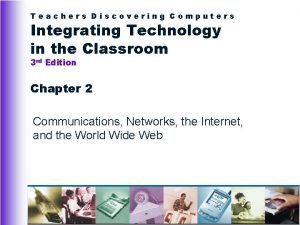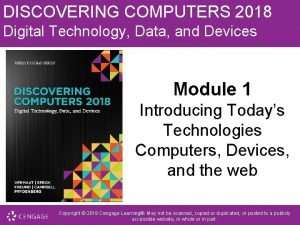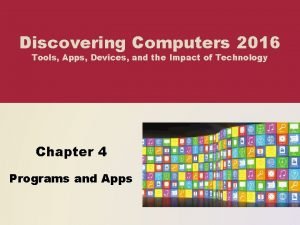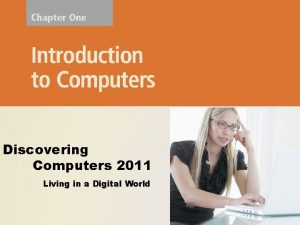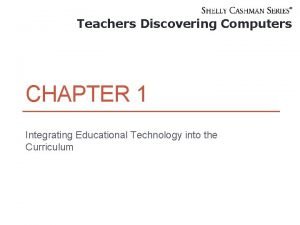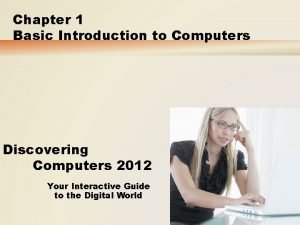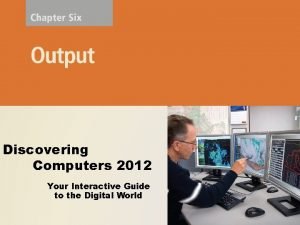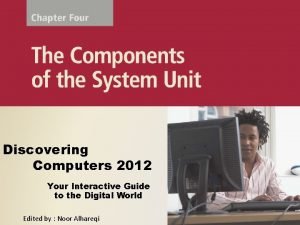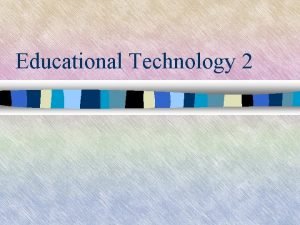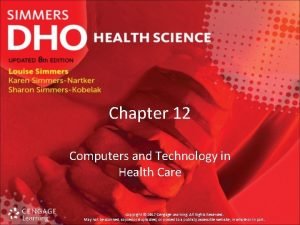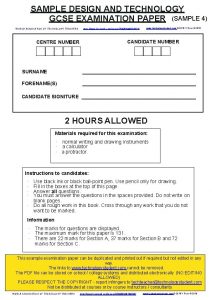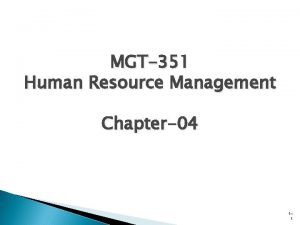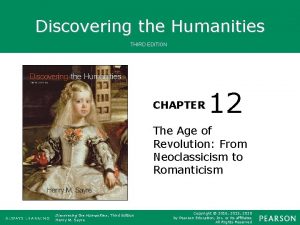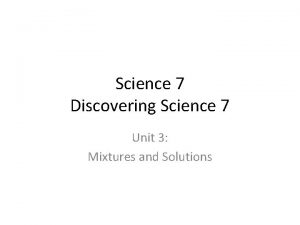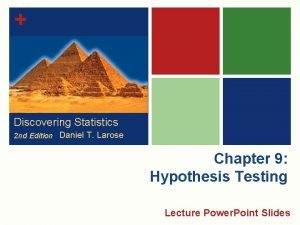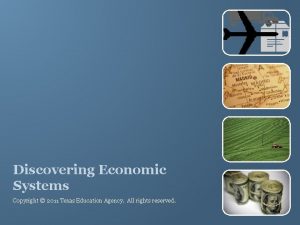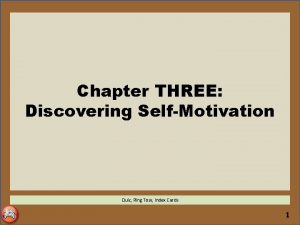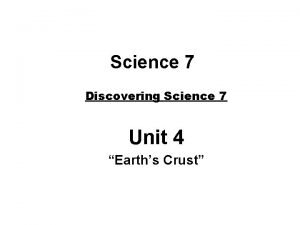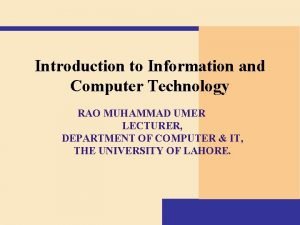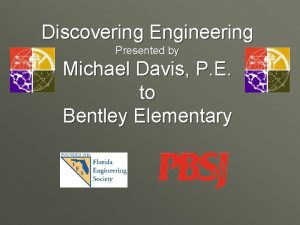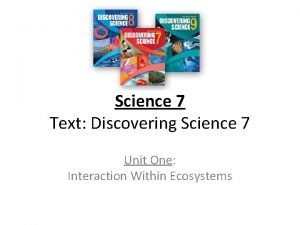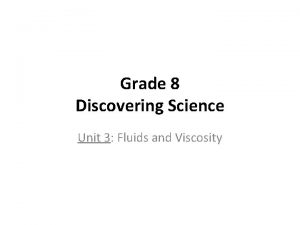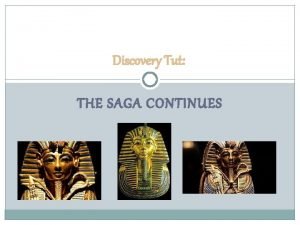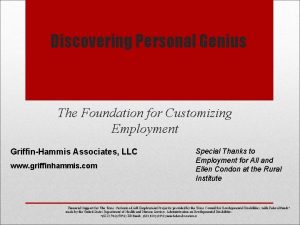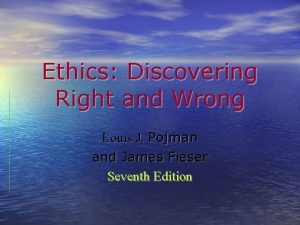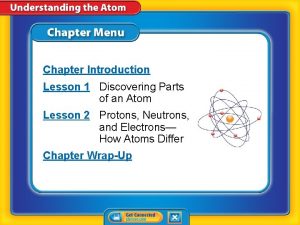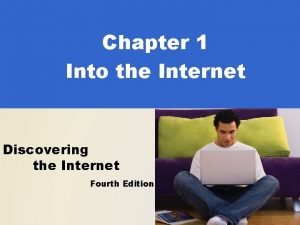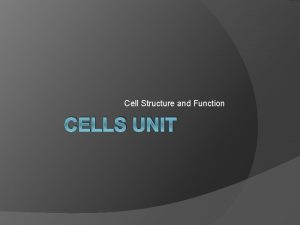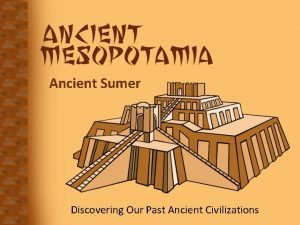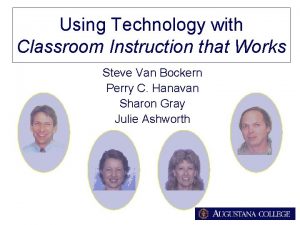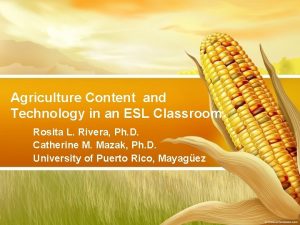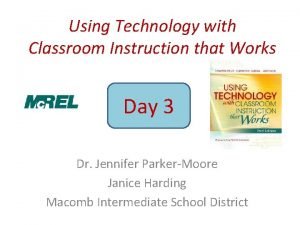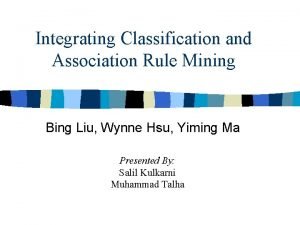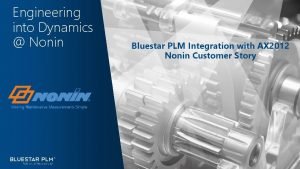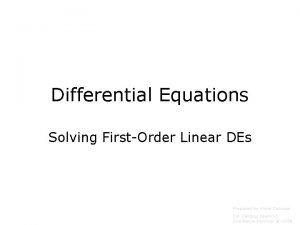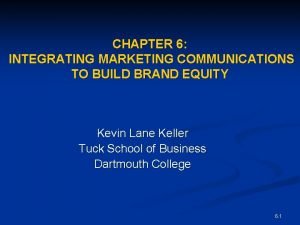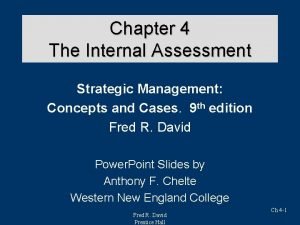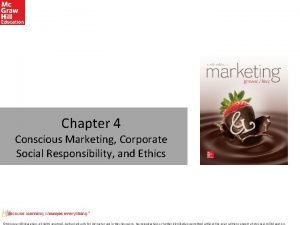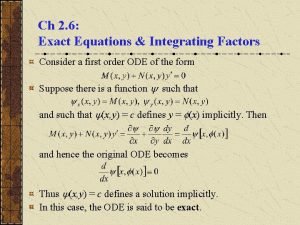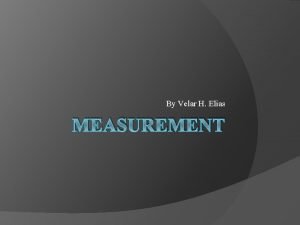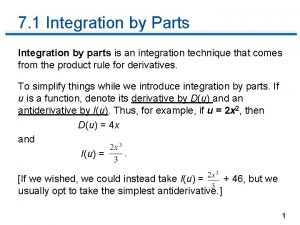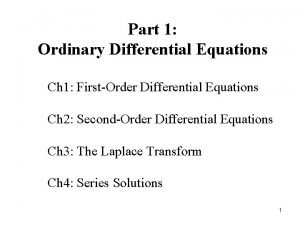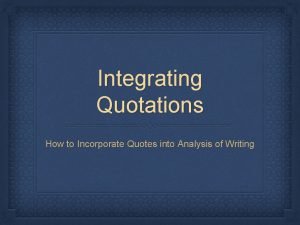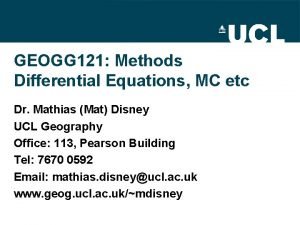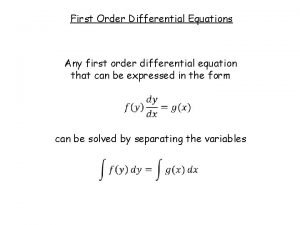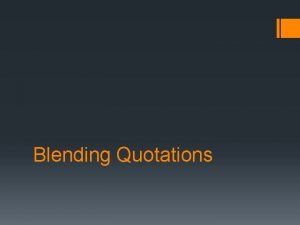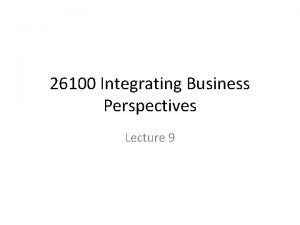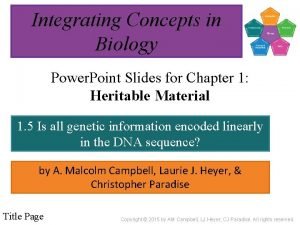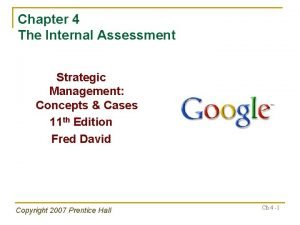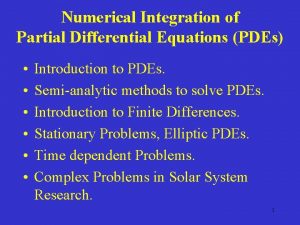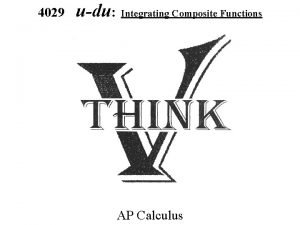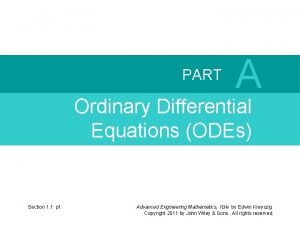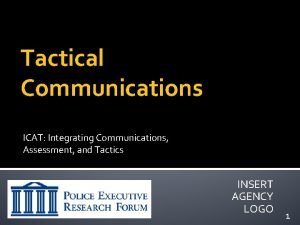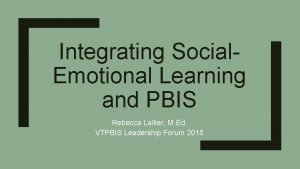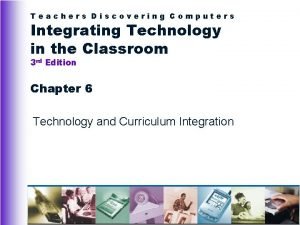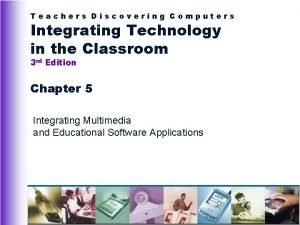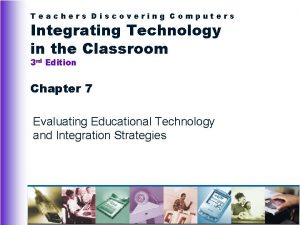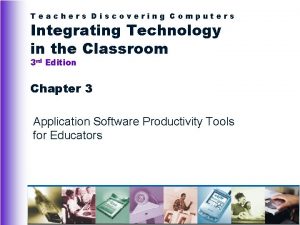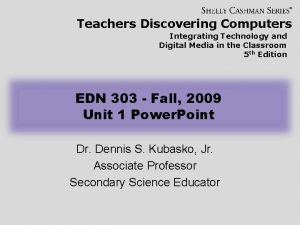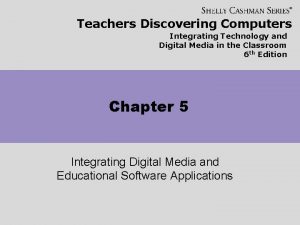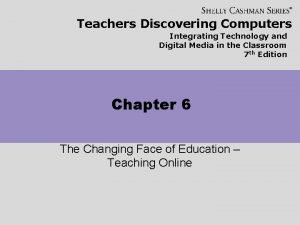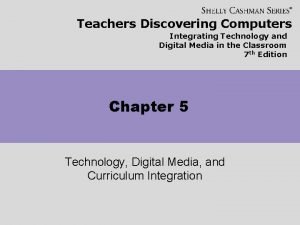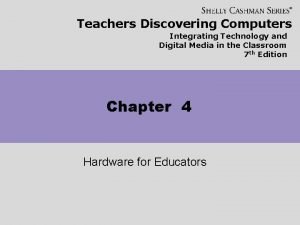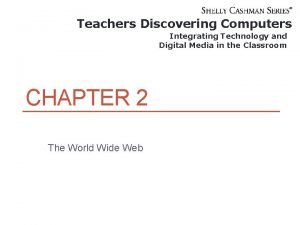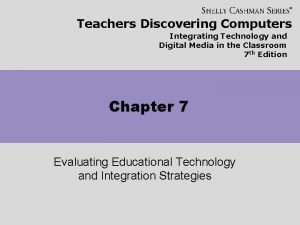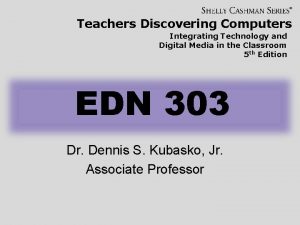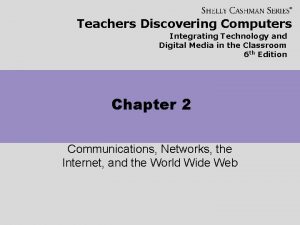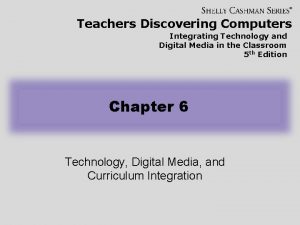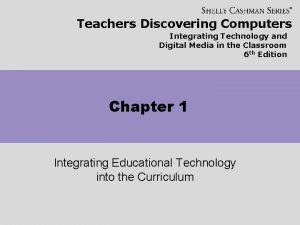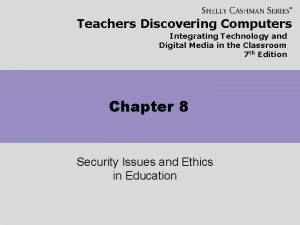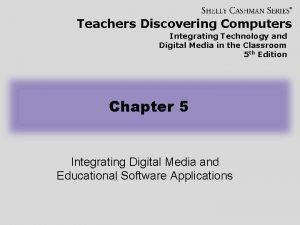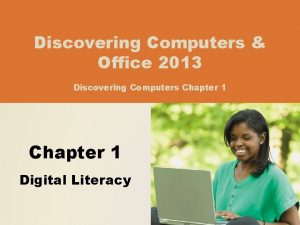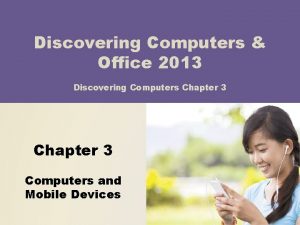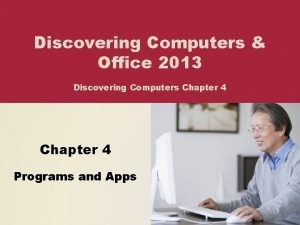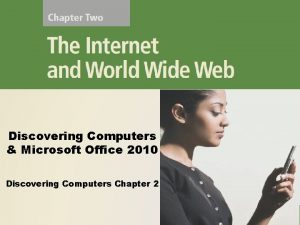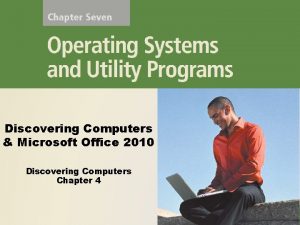Teachers Discovering Computers Integrating Technology in the Classroom
























































































- Slides: 88

Teachers Discovering Computers Integrating Technology in the Classroom 3 rd Edition Chapter 1 Introduction to Integrating Technology in Education

CHAPTER 1 OBJECTIVES Explain the difference between computer, information, and integration literacy b Define and describe computers and their functions b Identify the major components of a computer b Explain the four operations of the information processing cycle: input, process, output, and storage b 2

CHAPTER 1 OBJECTIVES Explain how speed, reliability, accuracy, storage, and communications enable computers to be powerful tools b Differentiate among the various categories of software b Explain the purpose of a network b Discuss the uses of the Internet and the World Wide Web b 3

CHAPTER 1 OBJECTIVES Explain why computer technology is important for education b Describe the National Educational Technology Standards (NETS-T) for Teachers b Provide examples of how computers are changing the way people teach and learn b 4

CURRICULUM-SPECIFIC LEARNING b Learning how to apply teaching principles, knowledge, and ideas to authentic and practical classroom lessons and projects that can benefit your students 5

COMPUTER, INFORMATION AND INTEGRATION LITERACY b b b Computer literacy • Knowledge and understanding of computers and their uses Information literacy • Knowing how to find, analyze, and use information Integration literacy • The ability to use computers and other technologies combined with a variety of teaching and learning strategies 6

Computers are present in every aspect of daily living – in the workplace, at home, in the classroom, and for entertainment 7

WHAT IS A COMPUTER AND WHAT DOES IT DO? b An electronic machine that can accept data (input), manipulate the data according to specified rules (process), produce results (output), and store the results for future use 8

WHAT IS A COMPUTER AND WHAT DOES IT DO? b Data – collection of unorganized facts b Information – organized data b Input – data entered into a computer b Processing – activity of organizing data b Output – processed results from a computer 9

WHAT IS A COMPUTER AND WHAT DOES IT DO? b Storage – holding data and information for future use b Information processing cycle – the cycle of input, process, output, and storage b User – a person who communicates with the computer b Hardware – the physical equipment that makes up the computer b Software – a series of instructions that tells the hardware how to perform tasks 10

Processing data into information 11

THE COMPONENTS OF A COMPUTER b Variety of hardware components that work together with software to carry perform calculations, organize data, and communicate with other computers 12

THE COMPONENTS OF A COMPUTER b Input devices b Output devices b System unit b Storage devices b Communications devices 13

14

15

PERSONAL COMPUTERS b. A computer designed for use by one person at a time 16

MOBILE COMPUTERS AND MOBILE DEVICES b Mobile Computers • Notebook computer • Tablet PC b Mobile Devices • Handheld Computer • PDA • Smart Phones 17

WHY IS A COMPUTER SO POWERFUL? b Speed b Reliability b Accuracy b Storage b Communications • Network • Electronic mail 18

The Internet is a worldwide collection of networks that links together millions of business, the government, educational institutions, and individuals 19

COMPUTER SOFTWARE b Computer programs • A series of instructions that tells the hardware of a computer what to do and how to do it • Stored on various storage media • Installing programs • Running programs 20

When you buy software, you receive media such as a CD-ROMs or a DVD-ROM that contains the software program 21

22

COMPUTER SOFTWARE b System software • Operating system – Microsoft Windows – Mac OS 23

COMPUTER SOFTWARE b System software • User interface – Graphical user interface (GUI) – Microsoft Windows – Mac OS 24

COMPUTER SOFTWARE b System software • Utility programs • Application software 25

COMPUTER SOFTWARE b Application software • Software suites – – – Word Processing Spreadsheet Database Presentation graphics Communication Apple. Works is a popular suite used by teachers and students primarily on Macintosh computers 26

COMPUTER SOFTWARE b Application software • Packaged software is available at computer stores, office equipment suppliers, retailers, 27 and the Internet

COMPUTER SOFTWARE b Application software • Custom software • Shareware, freeware, and public domain software • Software development – Computer Programmers – Systems Analyst 28

NETWORKS AND THE INTERNET b Network • A collection of computers and devices connected together via communications media and devices – Local area network – LAN – Wide area network – WAN 29

A local area network (LAN) enables two separate computers to share the same printer 30

A wide area network (WAN) can be quite large and complex, connecting users in offices around the country 31

NETWORKS AND THE INTERNET b The Internet • World’s largest network – E-mail – Information – Shopping – Meeting people – Entertainment 32

33

NETWORKS AND THE INTERNET b Internet Service Provider (ISP) b Online Service b World Wide Web (WWW) • Web pages • Web site • Web browser 34

35

WHY USE COMPUTER TECHNOLOGY IN EDUCATION? b Technology is everywhere b Technology can support learning b Computers support communications beyond classroom walls b Support of national and international organizations 36

The ISTE technology standards and performance indicators provide a framework for implementing technology in teaching and learning 37

AN EXAMPLE OF HOW ONE SCHOOL USES COMPUTERS b Ridgedale High School • All computers on a local area network • Three labs of 30 computers each – PC and Macintosh • Internet connection in each classroom 38

Ridgedale High School’s Web site allows teachers, students, and parents to have direct access to extensive and up-to-date school-related information 39

AN EXAMPLE OF HOW ONE SCHOOL USES COMPUTERS b Superintendent • Technology plan • Committee members can access the plan remotely 40

AN EXAMPLE OF HOW ONE SCHOOL USES COMPUTERS b Principal • Sending several email messages to teachers and staff • Overseeing technology purchases and implementation 41

AN EXAMPLE OF HOW ONE SCHOOL USES COMPUTERS b School secretary • Automated phone system • Database software • Desktop publishing 42

AN EXAMPLE OF HOW ONE SCHOOL USES COMPUTERS b Technology coordinator • Supporting systems • Problem solving 43

AN EXAMPLE OF HOW ONE SCHOOL USES COMPUTERS b Cafeteria manager • Purchasing and inventory • Enrollment in school lunch program 44

AN EXAMPLE OF HOW ONE SCHOOL USES COMPUTERS b Media specialist • Maintains online catalog • Creates classroom activities • Runs media center 45

AN EXAMPLE OF HOW ONE SCHOOL USES COMPUTERS b Teachers • Create classroom presentations • Research assignments • Group laptop computers • Monitor student progress 46

AN EXAMPLE OF HOW ONE SCHOOL USES COMPUTERS b Parent • Web site links parents and school • Keep track of events • School information 47

AN EXAMPLE OF HOW ONE SCHOOL USES COMPUTERS b Community • Links school and community • Students teach senior citizens how to use a computer 48

CHAPTER SUMMARY b Explain the difference between computer, information, and integration literacy b Define and describe computers and their functions b Identify the major components of a computer b Explain the four operations of the information processing cycle: input, process, output, and storage 49

CHAPTER SUMMARY b Explain how speed, reliability, accuracy, storage, and communications enable computers to be powerful tools b Differentiate among the various categories of software b Explain the purpose of a network b Discuss the uses of the Internet and the World Wide Web 50

CHAPTER SUMMARY b Explain why computer technology is important for education b Describe the National Educational Technology Standards (NETS-T) for Teachers b Provide examples of how computers are changing the way people teach and learn 51

Teachers Discovering Computers Integrating Technology in the Classroom 3 rd Edition Chapter 1 Complete

Milestones in Computer History 53

Dr. John V. Atanasoff and Clifford Berry design and build the first electronic digital computer. Their machine, the Atanasoff-Berry-Computer, or ABC, provides the foundation for advances in electronic digital computers During World War II, British scientist Alan Turing designs the Colossus, an electronic computer created for the military to break German codes. The computer’s existence is kept secret until the 1970 s. 54

Dr. John von Neumann writes a brilliant paper describing the stored program concept. His breakthrough idea, where memory holds both data and stored programs, lays the foundation for all digital computers that have since been built. Dr. John W. Mauchly and J. Presper Exkert, Jr. complete work on the first large-scale electronic, general-purpose digital computer. The ENIAC (Electronic Numerical Integrator and Computer) weighs 30 tons, contains 18, 000 vacuum tubes, occupies a 30 -by-50 -foot space, and consumes 160 kilowatts of power. The first time it is turned on, lights dim in an entire section of Philadelphia. 55

William Shockley, John Bardeen, and Walter Brattaim invent the transfer resistance device, eventually called the transistor. The transistor would revolutionize computers, proving much more reliable than vacuum tubes. The first commercially available electronic digital computer, the UNIVAC I (UNIVersal Automatic Computer), is introduced by Remington Rand. Public awareness of computers increases when the UNIVAC I, after analyzing only 5 percent of the popular vote, correctly predicts that Dwight D. Eisenhower will win the presidential election. 56

Dr. Grace Hopper considers the concept of reusable software in her paper, “The Education of a Computer. ” The paper describes how to program a computer with symbolic notation instead of the detailed machine language that had been used. The IBM model 650 is one of the first widely used computer systems. Originally planning to produce only 50 machines, the system is so successful that eventually IBM manufactures more than 1, 000. With the IBM 700 series of machines, the company will dominate the mainframe market for the next decade. 57

The IBM 305 RAMAC system is the first to use magnetic disk for external storage, This system provides storage capacity similar to magnetic tape that previously was used, but offers the advantage of semi-random access capability. FORTRAN (FORmula TRANslation), an efficient, easy-to-use programming language, is introduced by John Backus. 58

Computers built with transistors mark the beginning of the second generation of computer hardware. More than 200 programming languages have been created. IBM introduces two smaller, desk-sized computers: the IBM 1401 for business and the IBM 1602 for scientists. The IBM 1602 initially is called the CADET, but IBM drops the name when campus wags claim it is an acronym for, Can’t Add, Doesn’t Even Try. 59

COBOL, a high-level business application language, is developed by a committee headed by Dr. Grace Hopper. COBOL uses English-like phrases and runs on most business computers, making it one of the more widely used programming languages. The number of computers has grown to 18, 000. Third-generation computers, with their controlling circuitry stored on chips, are introduced. The IBM System/360 computer is the first family of compatible machines, merging science and business lines. 60

Digital Equipment Corporation (DEC) introduces the first mini-computer, the PDP-8. The machine is used extensively as an interface for time-sharing systems. Dr. John Kemeny of Dartmouth leads the development of the BASIC programming language. Alan Shugart at IBM demonstrates the first regular use of an 8 -inch floppy (magnetic storage disk). In a letter to the editor entitled “GO TO Statements Considered Harmful, ” Dr. Edsger Dijsktra introduces the concept of structured programming, developing standards for constructing computer programs. Computer Science Corporation becomes the first 61 software company listed on the NYSE.

Under pressure from the industry, IBM announces that some of its software will be priced separately from the computer hardware. This unbundling allows the software firms to emerge in the industry. The ARPANET network, a predecessor of the Internet, is established. Fourth-generation computers, built with chips that use LSI (large-scale integration) arrive. While the chips used in 1965 contained as many as 1, 000 circuits, the LSI chip contains as many as 15, 000. 62

Dr. Ted Hoff of Intel Corporation develops a microprocessor, or microprogrammable computer chip, the Intel 4004. MITS, Inc. advertises the first microcomputer, the Altair. Named for the destination in an episode of Star Trek, the Altair is sold in kits for less than $400. Although initially it has no keyboard, no monitor, no permanent memory, and no software, 4, 000 orders are taken within the first three months. Ethernet, the first local area network (LAN), is developed at Xerox PARC (Polo Alto Research Center) 63

Steve Wozniak and Steve Jobs build the first Apple computer. A subsequent version, the Apple II, is an immediate success. Adopted by elementary schools, high schools, and colleges, for many students the Apple II is their first contact with the world of computers. Visi. Calc, a spreadsheet program written by Bob Frankston and Dan Bricklin, is introduced. Originally written to run on Apple II computers, Visi. Calc will be seen as the most important reason for the acceptance of personal computers in the business world. The first public online information services, Compu. Serve and the Source, are founded. 64

Alan Shugart presents the Winchester hard drive, revolutionizing storage for personal computers. IBM offers Microsoft Corporation co-founder, Bill Gates, the opportunity to develop the operating system for soon-to-be announced IBM personal computer. With the development of MS-DOS, Microsoft achieves tremendous growth and success. The IBM PC is introduced, signaling IBM’s entrance into the personal computer marketplace. The IBM PC quickly garners the largest share of the personal computer market and becomes the personal computer choice in business. 65

3, 275, 000 personal computers are sold, almost 3, 000 more than in 1981. Hayes introduces the 300 bps smart modem. The modem is an immediate success. Compaq, Inc. is founded to develop and market IBMcompatible PCs. Lotus Development Corporation is founded. Its spreadsheet software, Lotus 1 -2 -3, which combines spreadsheet, graphics, and database programs in one package, becomes the best-selling program for IBM personal computers. Instead of choosing a person for its annual award, TIME magazine names the computer Machine of the Year for 1982, acknowledging the impact of computers 66 on society.

IBM introduces a personal computer, called the PC AT, that uses the Intel 80286 microprocessor. Hewlett-Packard announces the first Laser. Jet printer for personal computers. Apple introduces the Macintosh computer, which incorporates a unique, easy-to-learn, graphical user interface. Several personal computers utilizing the powerful Intel 80386 microprocessor are introduced. These machines per-form processing that once only large systems could handle. 67

Microsoft surpasses Lotus Development Corporation to become the world’s top software vendor While working at CERN Switzerland, Tim Berners-Lee invents an Internet-based hypermedia enterprise for information sharing. Berners-Lee will call this innovation the World Wide Web. The International Society for Technology in Education (ISTE) is formed. The mission of ISTE is to help K-12 classroom teachers and administrators share effective methods for enhancing student learning with new classroom technologies. Today, ISTE has more than 6, 000 members and a network of regional affiliates 68 with a membership that exceeds 40, 000.

Ask. ERIC (Educational-Resources Information Center) starts up as a project of the ERIC Clearinghouse on Information and Technology at Syracuse University. Today, the federally funded Ask. ERIC provides an Extensive and searchable database of documents and resources; educators can send questions on any educational topic to Ask. ERIC and receive a response within 48 hours. Microsoft releases Windows 3. 1, the latest version of its Windows operating system. Windows 3. 1 offers improvements such as True. Type fonts, multimedia capability, and object linking and embedding (OLE). In two months, 3, 000 copies of Windows 3. 1 are sold. 69

Several companies introduce computer systems using the Pentium® microprocessor from Intel. The Pentium® chip is the successor to the Intel 486 processor. It contains 3. 1 million transistors and is capable of performing 112, 000 instructions per second. The International Society for Technology in Education (ISTE) introduces the first edition of “Technology Standards for Teachers, ” containing 13 indicators. Marc Andreessen creates a graphical Web browser called Mosaic. This success leads to the organization of Netscape Communications Corporation. 70

Jim Clark and Marc Andreessen found Netscape and launch Netscape Navigator 1. 0, a browser for the World Wide Web. The Clinton Administration creates the Telecommunications and Information Infrastructure Assistance Program (TIIAP), which supplies grants to public institutions to fund the installation of advanced communications technologies. Over the next four years, TIIAP awards 378 grants of approximately $118 million in federal grant funds, which are matched by more than $180 million in non-federal funds. 71

Microsoft releases Windows 95, a major upgrade to its Windows operating system. Windows 95 consists of more than 10, 000 lines of computer instructions developed by 300 person years of effort. More than 50, 000 individuals and companies test the software before it is released. Sun Microsystems launches Java, an object-oriented programming language that allows users to write one application for a variety of computer platforms. Java becomes one of the hottest Internet technologies. 72

President Clinton launches a two-billion dollar, fiveyear Technology Literacy Challenge – a program designed to catalyze and leverage state, local, and private sector efforts so American schools can provide students with the skills they need to succeed in the next century. U. S. Robotics introduces Palm. Pilot, a handheld personal organizer. The Palm. Pilot’s user friendliness and low price make it a standout next to more expensive personal digital assistants (PDAs). An innovative technology called webtv combines television and the Internet by providing viewers with tools to navigate the Web. 73

The Summer Olympics in Atlanta makes extensive use of computer technology, using an IBM network of 7, 000 personal computers, 2, 000 pagers and wireless devices, and 90 industrial-strength computers to share information with more than 150, 000 athletes, coaches, journalists, and Olympics staff members, and millions of Web Users. President Clinton signs the Telecommunications Act of 1996 into law. The Act’s Universal Service clause requires that schools and libraries are provided affordable telecommunication services. 74

Intel introduces the Pentium® II processor with 7. 5 million transistors. The new processor, which incorporates MMX™ technology, processes video, audio, and graphics data more efficiently and supports applications such as movie-editing, gaming, and more. The Federal Communications Commission approves the Education Rate (E-Rate) discount program to provide K-12 schools and all public libraries with discounted telecommunications services. FCC Chairman Hundt describes the E-Rate program as, “the biggest single national effort to change education in K 12 classrooms in the history of the country. ” Deep Blue, an IBM supercomputer, defeats world chess champion Gary Kasparov in a six-game chess competition. Millions of people follow the 9 -day-long 75 rematch on IBM’s Web site

DVD (Digital Video Disc), the next generation of optical disc storage technology, is introduced. DVD can store computer, audio, and video data in a single format, with the capability of producing a near-studio quality. By year’s end, 500, 000 DVD players are shipped worldwide. The International Society for Technology in Education (ISTE) releases the second edition of “Technology Standards for Teachers, ” containing 18 indicators organized into three major categories. Fifty million users are connected to the Internet and World Wide Web. 76

Microsoft ships Windows 98, an upgrade to Windows 95. Windows 98 offers improved Internet access, better system performance, and support for a new generation of hardware and software. In six months, more than 10, 000 copies of Windows 98 are sold worldwide. E-commerce, or electronic commerce – the marketing of goods and services over the Internet – booms. Companies such as Dell, E*TRADE, and Amazon. com spur online shopping, allowing buyers to obtain everything from hardware and software to financial and travel services, insurance, automobiles, books, and more. High school students began taking online courses at Florida High School Online. 77

More than 10, 000 people take up telecommuting, the capability of working at home and communicating with an office via computer. More and more firms embrace telecommuting to help increase productivity, reduce absenteeism, and provide greater job satisfaction. Apple Computer introduces the i. Mac, the latest version of its popular Macintosh computer. The i. Mac abandons such conventional features as a floppy disk drive but wins customers with its futuristic design, seethrough case, and easy setup. Consumer demand outstrips Apple’s production capabilities, and some vendors are forced to begin waiting lists. 78

Preparing Tomorrow’s Teachers to Use Technology (PT 3) – The U. S. Department of Education initiates a multi-year, innovative, $125 million grant program to create technology proficient educators at all levels: pre -service teachers, in-service teachers, and faculty in higher education. Intel, with support from Microsoft, launches the Intel Teach to the Future program – a worldwide initiative to help teachers effectively integrate the use of computer technology into classroom curriculum. 79

Intel releases its Pentium III processor, which provides enhanced multimedia capabilities. Microsoft introduces Office 2000, its premier productivity suite, offering new tools for users to create content and save it directly to a Web site without any file conversion or special steps. Governments and businesses frantically work to make their computer systems Y 2 K (Year 2000) compliant, spending more than $500 billion worldwide. Y 2 K non -compliant computers cannot distinguish if 01/01/00 refers to 1900 or 2000, and thus may operate using a wrong date. This Y 2 K bug can affect any application that relies on computer chips, such as ATMs, airplanes, energy companies, and the telephone system. 80

Shawn Fanning, 19, and his company, Napster, turn the music industry upside down by developing software that allows computer users to swap music files with one another without going through a centralized file server. The Recording Industry of America, on behalf of five media companies, sues Napster for copyright infringement. Intel unveils its Pentium 4 chip with clock speeds starting at 1. 4 GHz. The Pentium 4 includes 42 million transistors, nearly twice as many contained on its predecessor, the Pentium III. E-commerce achieves mainstream acceptance. Annual e-commerce sales exceed $100 billion, and Internet advertising expenditures reach more than $5 billion. 81

The International Society for Technology in Education (ISTE) releases the National Educational Technology Standards (NETS) for teachers and K-12 students. The National Council for Accreditation of Teacher Education adopts the NETS for teachers (NETS-T) for accrediting teacher education programs. According to the U. S. Commerce Department, Internet traffic is doubling every 100 days, resulting in an annual growth rate of more than 700 percent. It has taken radio and television 30 years and 15 years to reach 60 million people, respectively. The Internet has achieved the same audience base in 3 years. Dot. companies (Internet based) go out of business at a record pace – nearly one per day – as financial investors withhold funding due to the companies’ unprofitability. 82

Telemedicine uses satellite technology and videoconferencing to broadcast consultations and to perform distant surgeries. Robots are used for complex and precise tasks. Computer-aided surgery uses virtual reality to assist with training and planning procedures. Microsoft releases Microsoft Office 2001 suite for the Macintosh, which includes Word, Excel, Entourage, and Power. Point. Microsoft introduces Office XP Professional, which includes voice recognition and speech capabilities. Microsoft claims that Office XP is the ultimate set of business tools and that is a complete suite of software that is powerful enough to meet all personal and professional computing needs. 83

Wireless technology, especially handheld computers, achieves significant market penetration. Prices drop, usage increases, and wireless carries scramble for new services, particularly for a mobile workforce that can access the Internet anywhere at any time. More than 2. 5 million computer users subscribe to America Online and take advantage of AOL Anywhere features, including Instant Messenger, e-mail, and customized news and information pages. AOL’s merger with Time Warner combines the strengths of the Internet, entertainment, and communications industries. 84

Apple computers releases Mac. OS X, the latest version of its popular operating system. Apple claims that Mac OS X is the most advanced and easiest-to-use operating system in history. Microsoft releases Windows XP Professional for business and advanced home computing and Windows XP Home edition for home use. 85

The world of wireless communications, wireless notebook computers, and other wireless devices are breaking down traditional K-12 communication barriers worldwide and are opening new and exciting doors to a wireless world of learning. Microsoft releases Pocket PC 2002 software that allows PDAs to interface with PCs and Microsoftware. Handspring revolutionizes handheld devices by offering the first all-in-one device that has a built-in cell phone, Web-browsing, and e-mail features. 86

The International Society for Technology in Education (ISTE) announces that by summer of 2003, 48 states will adopt, adapt, and align with, or reference one set of its National Educational Technology Standards (NETS). The Tablet PC is introduced as the next-generation mobile PC. It runs Windows XP Tablet PC software and is designed like a notebook, is fully wireless, and includes note-taking and other new features. Microsoft releases the latest version of its flagship Office suite in numerous versions, including a Microsoft Office Student and Teacher Edition that includes Word 2003, Excel 2003, and Power. Point 2003. 87

The federal Education Rate, or E-Rate program, invests more than $14 billion, since 1998, to connect libraries and K-12 classrooms to the Internet. As a result, virtually all U. S. students now have access to the Internet from school. FCC Chairman Powell states that one of the more successful broadband projects that exists is the E-Rate program. By the end of 2004, experts predict that more than 1 billion people will send 244 billion e-mail messages monthly. 88
 Teachers discovering computers
Teachers discovering computers Discovering computers 2018 chapter 1 ppt
Discovering computers 2018 chapter 1 ppt Discovering computers 2016
Discovering computers 2016 Discovering computers 2011
Discovering computers 2011 Discovering computers 2018 chapter 1
Discovering computers 2018 chapter 1 Discovering computer
Discovering computer Tactile output
Tactile output Discovering computers 2012
Discovering computers 2012 Basic concepts on integrating technology in instruction
Basic concepts on integrating technology in instruction Kim kroll teachers pay teachers
Kim kroll teachers pay teachers Classroom language for teachers
Classroom language for teachers Test chapter 12 computers and technology in health care
Test chapter 12 computers and technology in health care Smart classroom vs traditional classroom
Smart classroom vs traditional classroom Sample design and technology gcse examination paper answers
Sample design and technology gcse examination paper answers Job analysis in hrm
Job analysis in hrm Discovering the humanities 4th edition
Discovering the humanities 4th edition Self motivation define
Self motivation define Discovering science 7
Discovering science 7 P value
P value Discovering economic systems guided practice
Discovering economic systems guided practice Readwise token
Readwise token Discovering science 7
Discovering science 7 Muhamed computer technology
Muhamed computer technology Discovering engineering
Discovering engineering Defining and debating america's founding ideals
Defining and debating america's founding ideals Discovering science 7
Discovering science 7 Example of fluid
Example of fluid A r williams author of discovering tut
A r williams author of discovering tut Discovering personal genius
Discovering personal genius Ethics discovering right and wrong
Ethics discovering right and wrong Chapter 7 lesson 1 discovering parts of an atom answer key
Chapter 7 lesson 1 discovering parts of an atom answer key Discovering the internet
Discovering the internet Discovering cells
Discovering cells Discovering our past ancient civilizations
Discovering our past ancient civilizations Using technology with classroom instruction that works
Using technology with classroom instruction that works Technology for the esl classroom
Technology for the esl classroom Using technology with classroom instruction that works
Using technology with classroom instruction that works Signal phrases
Signal phrases Embedded quotes mla examples
Embedded quotes mla examples Sensory
Sensory Integrating factor method
Integrating factor method Integrating classification and association rule mining
Integrating classification and association rule mining Dynamics plm
Dynamics plm Integrating factor of linear differential equation
Integrating factor of linear differential equation Integrating marketing communication to build brand equity
Integrating marketing communication to build brand equity Key internal forces
Key internal forces When should firms introduce conscious marketing
When should firms introduce conscious marketing Non exact ode calculator
Non exact ode calculator Integrating type dvm
Integrating type dvm Integration by parts tabular method
Integration by parts tabular method Relationship development
Relationship development Integrating factor
Integrating factor Integrate quotes
Integrate quotes Integrating factor of differential equation
Integrating factor of differential equation First ode
First ode Process indicators enable a software project manager to
Process indicators enable a software project manager to Blending quotations
Blending quotations Integrating business perspectives
Integrating business perspectives Integrating sources into your writing
Integrating sources into your writing Integrating science and social studies
Integrating science and social studies Integrating concepts in biology
Integrating concepts in biology Integrating strategy and culture in internal assessment
Integrating strategy and culture in internal assessment Integration of partial differential equation
Integration of partial differential equation Integration of composite functions
Integration of composite functions Integrating factor
Integrating factor Integrating qualitative and quantitative methods
Integrating qualitative and quantitative methods Integrating communications assessment and tactics
Integrating communications assessment and tactics Integrating sel and pbis
Integrating sel and pbis Integrating public health and primary care
Integrating public health and primary care Hát kết hợp bộ gõ cơ thể
Hát kết hợp bộ gõ cơ thể Bổ thể
Bổ thể Tỉ lệ cơ thể trẻ em
Tỉ lệ cơ thể trẻ em Chó sói
Chó sói Chụp tư thế worms-breton
Chụp tư thế worms-breton Chúa sống lại
Chúa sống lại Các môn thể thao bắt đầu bằng từ đua
Các môn thể thao bắt đầu bằng từ đua Thế nào là hệ số cao nhất
Thế nào là hệ số cao nhất Các châu lục và đại dương trên thế giới
Các châu lục và đại dương trên thế giới Công thức tính thế năng
Công thức tính thế năng Trời xanh đây là của chúng ta thể thơ
Trời xanh đây là của chúng ta thể thơ Cách giải mật thư tọa độ
Cách giải mật thư tọa độ Làm thế nào để 102-1=99
Làm thế nào để 102-1=99 độ dài liên kết
độ dài liên kết Các châu lục và đại dương trên thế giới
Các châu lục và đại dương trên thế giới Thể thơ truyền thống
Thể thơ truyền thống Quá trình desamine hóa có thể tạo ra
Quá trình desamine hóa có thể tạo ra Một số thể thơ truyền thống
Một số thể thơ truyền thống Cái miệng nó xinh thế
Cái miệng nó xinh thế
